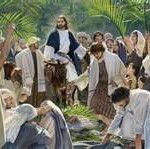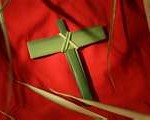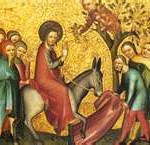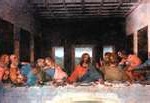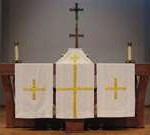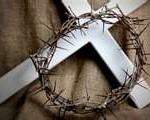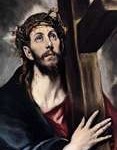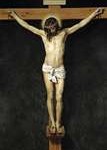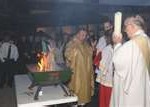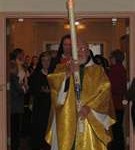My series on the “Journey to Easter…Symbols and Traditions” continues.
Palm Sunday falls on the last Sunday before Easter, and is the sixth and last sunday of Lent. It is also the first day of Holy Week, a week of observances commemmorating the last days in Jesus’ life. On Palm Sunday, Christians remember the triumphal entry into Jerusalem. The Bible accounts recount how He was mounted on a donkey and rode into Jerusalem with crowds waving palm branches, tossing them into his path along with cloaks. He was greeted with cries of “Hosanna”, which means “Save,we pray” or “Save now”
Palm Sunday church services often reenact this triumphal entry by worshippers gathering outside the church and entering with palm branches. In some traditions, the palm branches are blessed and returned to worshippers. These services then turn to a recounting of the Passion story in which a disciple betrays Jesus, the Roman governor, Pontius Pilate sentences Him to death, and a crowd witnesses his crucifixion.
- Triumphal Entry into Jerusalem
- Cross Made Of Palms
- Triumphal Entry-Laying Cloaks
- Maundy Thursday Last Supper
- Maundy Thursday-Eucharist
- Maundy Thursday-Footwashing
- Good Friday-Cross & Crown
- Good Friday-Jesus Carrying Cross
- Good Friday-Crucifixion
- Easter Vigil-Relighting Paschal Candle
- Easter Vigil,Procession
- Easter Vigil-Sharing Light
The remaining days of Holy Week are as follows:
- Maundy Thursday Commemorates the Last Supper and the arrest of Jesus in the Garden of Gethsemane. Jesus ate his last meal with his disciples, an observation of the Passover. During this meal, Jesus began by washing the feet of his disciples, and proceeded to break the bread and share the wine by giving the disciples to continue this practice as a way of remembering his sacrifice for them. This is the beginning of the tradition of the Lord’s Supper or Eucharist. In Maundy Thursday services, the Lord’s Supper is celebrated and the Lenten fast is ended. Some churches devote themselves to a reconciliation of penitents. Some reenact the footwashing ceremony as a means of remembering servanthood. Some also strip the altar of cloth coverings, to prepare for the starkness of the Good Friday services.
- Good Friday Commemorates the Crucifixion and death of Jesus on the cross. The Passion events include beating, questioning and sentencing to death. Roman soldiers place a crown of thorns on Jesus head and require him to carry his cross to a place called Golgotha, where he is nailed to a cross to die. Services can center around veneration of the cross, a consideration of the seven last utterances of Jesus on the cross, Tenebrae which focuses on descent into darkness, a night-time devotion (Pesame) focusing on the grief of Mary Jesus’ mother or the Stations of the Cross,
- Easter Vigil Commemorates the darkness of the grave and the Resurrection which took place during the night. Most contemporary services feature the elements of kindling a new flame, the lighting of many candles, including the paschal candle, the baptism of new members, Bible readings and the celebration of the Lord’s Supper. This vigil service marks the end of many prohibitions practiced during Lent, including the breaking of fasts, using the word “alleluia”, ringing bells and unveiling images that were veiled. This can be a service timed to end at midnight or merely an evening service.

